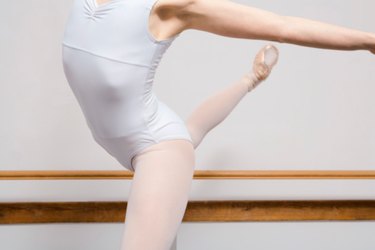
Ballerinas make it look effortless, but that's part of the illusion. This highly stylized dance form requires rigorous training that usually begins in childhood. Girls who go on to become professionals are under intense pressure throughout their careers to stay thin. "Black Swan" lead actress Natalie Portman, slender even before she lost 20 lbs. following a dancer's diet and exercise regimen, said it was the most difficult thing she'd ever done.
Dancers and Eating Disorders
Video of the Day
In 1986, Gelsey Kirkland, former principal dancer with the New York City Ballet and the American Ballet Theater, published "Dancing on my Grave," an autobiographical memoir that exposed the prevalence of eating disorders such as anorexia and bulimia in the ballet world. A study published in the September 2006 "International Journal of Eating Disorders" focused on 29 ballerinas, finding that 83 percent had some form of eating disorder. Today, many ballet schools and companies employ nutritionists to help dancers keep their weight down while eating a balanced diet.
Video of the Day
The Ideal Ballerina's Body

The so-called "Balanchine body," named for the preference of the founder of the New York City Ballet, is considered the ideal: a small head on a long neck, long arms and legs, and a shortened torso. To be able to sustain the on-stage illusion that they float in an almost gravity-free world, dancers must follow a punishing regime of daily physical training to keep muscles elongated and powerful without the appearance of bulk. To get into a ballet company and advance through the ranks, a dancer's body must be thin without crossing the line to emaciation.
Special Dietary Challenges
In an essay for the Rudolf Nureyev Foundation Medical Website, Dr. Paule Nathan, a Paris endocrinologist and nutritionist, writes that an effective diet for dancers targets excess fat while sparing muscle mass and strength. Striving for rapid weight loss with drastic restrictions in food intake is never desirable. Instead, dancers must follow a diet that allows weight loss to be maintained with balanced eating habits. When additional energy is needed, the body must be trained to draw it from fat reserves rather than using new food to make more fat. Dancers should try to eat their three to four meals a day before they feel hungry because hunger tells the body to store calories from food in fatty tissue.
Advice to Dancers: Don't Eat Less -- Eat Differently
Nathan counsels dancers to avoid all high-fat foods, sweet foods and drinks, and alcohol in any form. A good breakfast consists of bread or cereal, low-fat milk and yogurt, and stewed fruit or fruit juice. Breakfast should never be skipped or the body will try to convert calories from lunch into fat, she warns. Nathan recommends 1.6 oz. of protein a day for every 100 lbs. of body weight, the best sources being fish, shellfish or lean meat. A dancer's diet should include lots of green vegetables seasoned with herbs or spices, but consumption of butter, oil, starch and cheese should be strictly limited. Fruit is fine in moderation. Dancers should chew food very slowly and keep a detailed food diary to help them assess what further changes they can make if they aren't meeting their weight goals.